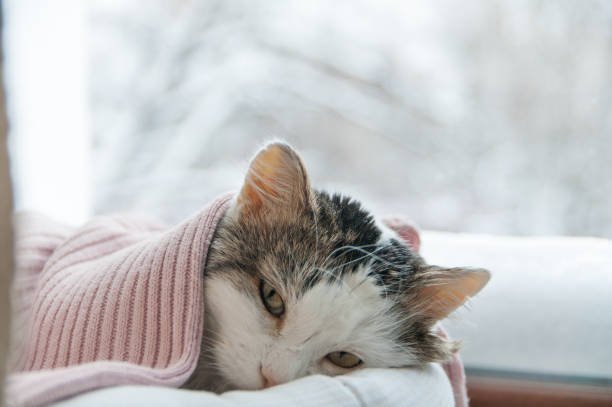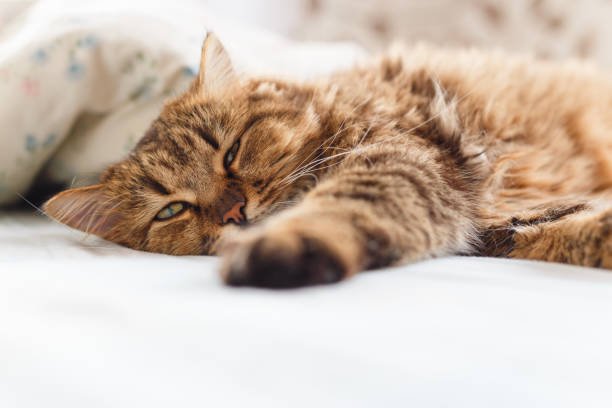- Can cats catch colds from humans?
No, the viruses that cause colds in humans, such as rhinoviruses, do not infect cats. However, other conditions or stress can make cats more susceptible to illness.
- What role does diet play in preventing cat colds?
A balanced, high-quality diet boosts a cat’s immune system, making them less susceptible to colds. Supplementing with vet-approved vitamins or omega-3 fatty acids may further support their immunity.
Unveiling Cat Colds: Shocking Symptoms & Secrets
Author Fakhir Zia Update 04/12/25
Published by M Taha Ali

If you notice your cat showing signs of a runny nose, sneezing, or watery eyes, it could be suffering from a cat cold. These symptoms are often related to upper respiratory tract infections, which are fairly common among felines. A mild fever might also accompany these signs, making your pet feel under the weather. It’s important to monitor your cat closely, as congestion can cause discomfort and lead to loss of appetite.
If these symptoms persist or worsen, it’s wise to reach out to a trusted DVM (Doctor of Veterinary Medicine).Often, cat colds from viruses or bacteria resolve on their own, much like human colds. However, you should not hesitate to seek veterinary care if the illness seems more severe.
Cat Colds Key Signs & Hidden Insights
Cats catch colds via direct contact or contaminated items; key symptoms include sneezing, nasal discharge, watery eyes, and breathing difficulties. Feline herpesvirus and calicivirus are primary culprits, with stress and crowded conditions triggering flare-ups. Prompt vet diagnosis and supportive care (warmth, hydration, proper nutrition) are essential; prevention depends on hygiene, limited exposure, and vaccination.
How Do Cats Catch a Cold?
Cats can catch a cold from various sources, especially when they interact with sick or infected animals.Indoor cats are less likely to catch colds than outdoor cats but can be affected if viruses enter the home. I’ve seen even the most secure indoor environments compromised when a virus is inadvertently carried in on clothing or shoes
The cold virus often spreads through direct contact, such as grooming or licking each other. It can also spread through sneezing, coughing, or even by coming into contact with contaminated items, like shoes or hands. Stress, malnutrition, or immune system deficiencies can also make a cat more prone to developing an upper respiratory infection (URI).
Veterinary observations indicate that crowded environments like boarding facilities or shelters increase cats’ cold risk due to proximity to animals.The cold virus may reactivate in cats after dormancy, especially under stress or insufficient nutrition, including lack of mother’s milk.
Although the cold virus affects cats, it does not spread to humans; humans cannot catch a cat cold. Reducing a cat’s cold risk means using reputable boarding and limiting exposure to sick animals.
Cat Cold Symptoms
Sneezing, runny nose, and watery eyes are classic hints your cat is under the weather. You might catch them squinting or struggling to breathe through a blocked nose, leading to loud sniffles or even gasping for air. Pair this with lethargic behavior like needing extra rest or showing a reduced appetite and it’s clear they’re unwell.
Watch for yellow nasal discharge turning to green mucus, a red flag for a bacterial infection. I’ve noticed that a mild fever (up to 102.5 degrees Fahrenheit) or dehydration from being too tired or depressed to drink worsens things. Check their mouth for ulcers, swollen gums, or red areas in the oral cavity. These subtle clues scream “vet visit now!”
If your cat starts coughing, wheezing or shows acute respiratory distress (like difficulty breathing or increased salivation), drop everything. These signal serious complications like bronchopneumonia. Trust me, delaying antibiotics or a veterinarian’s help could turn a simple cold into a nightmare.
Common Causes How Do Cats Get Colds?
Feline herpesvirus and calicivirus viral pathogens behind 90% of cat colds spread through shared spaces or direct contact, making prevention (vaccines, hygiene) essential for responsible care. Understanding these common causes helps curb estimated outbreaks; effective treatment (like antivirals) tackles infections early, stopping most mild colds from worsening.
Feline Herpesvirus
Feline herpesvirus (FHV-1), or rhino tracheitis, is highly contagious, spreading through direct contact via shared food, water, or bowls in shelters. Many cats in boarding or grooming facilities seem healthy but carry the virus. It remains dormant until stress reactivates it. The virus weakens cats’ defenses, leading to severe respiratory symptoms including sneezing, runny nose, and conjunctivitis with corneal ulcers.
Infected cats groomed or boarded during active periods develop recurrent infections that flare within days, leaving them not fully healthy. Dr. Marty Becker stresses that stress-induced flare-ups are common in cats, and early detection is vital for effective management. FHV-1 spreads through respiratory droplets or shared spaces, causing multiple infections throughout a cat’s life.
Stress can activate the dormant virus, triggering symptoms like watery eyes or nasal discharge. Many cats rest perfectly fine between periods but experience recurrent flare-ups look for subtle signs like squinting or congestion to catch it early.
Feline Calicivirus
Feline calicivirus is highly contagious, spreading easily among cats through respiratory droplets or shared objects. Infected cats show herpes-like symptoms such as sneezing, oral ulcers, and mouth sores, yet FCV causes lameness and respiratory infections. Core vaccines for kittens and adult cats help prevent serious disease, though they can’t completely stop infection due to numerous strains that exist.
FCV typically causes mild viral symptoms, but prevalent strains can trigger severe infections with painful ulcers in the mouth. Vaccination remains essential to reduce outbreaks, especially in multi-cat homes where viruses thrive.
Dr. Marty Becker notes that persistent stress and exposure cause recurrent outbreaks in cats, who can’t escape these specific pathogens.Feline calicivirus is here to stay, but smart care keeps kittens safe.
How does a Vet Diagnose Cat Cold?

A veterinarian collects history, asking about sneezing, nasal discharge, and onset to decide if it’s viral or pneumonia. They check for respiratory distress, mouth ulcers, or swollen eyes. Then, tests rule out asthma or fungal conditions. PCR testing is essential: swabs from the nose, throat, and eyes are carefully examined to detect Feline Herpesvirus or Calicivirus.
Veterinarians note that although cats rarely lie, their observable symptoms often mislead, making accurate diagnosis both challenging and indeed critical.a trusted vet once told me blood tests assess overall health, while chest scans spot complications like bacteria-driven infections needing precise treatment.
For recurrent signs, vets like Dr. Marty Becker stress laboratory testing to identify pathogens causing upper respiratory issues. Even mild cases get nasal secretions submitted for testing because what looks like a simple cold could mask serious viruses. Diagnosis isn’t guesswork; it’s science meeting whiskers.
How to Treat a Cat With a Cold?
Caring for a cat with a cold requires attention and gentle care. Creating a secure and warm environment is essential for helping your house cat feel better. Offer plenty of rest and provide loving care to aid in recovery. Use a soft, damp cloth to gently clean their nose and eyes, removing any runny or gunky discharge.
A humidifier can add humidity to the air, easing nasal congestion and irritation in the airways. If your cat is congested, place it in a pet carrier with a blanket while steaming the bathroom using hot water. This helps to clear their nasal passages and make breathing easier.
Dr. Marty Becker advises that after consulting your vet, support your cat’s immune system with nutrient-rich supplements or vitamins. Make sure your cat continues to eat and drink, as this prevents dehydration. Warming up their food slightly can make it more appealing and easier to swallow. Ensure they have an extra blanket in their bed or favorite place to curl up and stay comfortable.
Avoid giving them human cold medication, as it can be dangerous. If symptoms worsen, including breathing difficulties or lack of response to care, consult your veterinarian for an appropriate treatment plan. The treatment plan may include antibiotic eye drops or oral antibiotics to effectively treat secondary bacterial infections and boost recovery.
Pay attention to Cat Eating and Drinking
Monitor your cat’s behaviour and eating habits; if they aren’t eating or drinking, take steps to ensure proper intake. In some cases, hand-feeding warmed-up food can make a big difference. Regularly monitor their condition to address any worsening symptoms promptly. With careful attention, your cat can regain its strength and appetite in no time.
To prevent your pet from becoming dehydrated, you can mix water into their food. This ensures they stay hydrated while continuing to receive proper nutrition.
When to Visit the Vet
Cat colds are generally harmless and resolve in 1-2 weeks, yet specific signs should prompt a vet visit.If your pet doesn’t improve in 5 to 10 days or worsens, schedule a veterinary appointment immediately. Warning signs: difficulty breathing, green or yellow nasal discharge, vomiting, diarrhea, or not eating for 24 hours may indicate pneumonia.
Older cats, unvaccinated kittens, and cats with existing conditions are more vulnerable to severe cold effects and require extra caution. Regular preventative care plays a key role in your cat’s health. Ensure your cat receives vaccinations during their annual veterinary checkups to reduce the frequency and severity of upper respiratory infections.
While a vaccine for the common cold doesn’t exist for humans, fortunately, it does for cats, which helps in reducing risks. Keeping your cat indoors in a healthy environment helps prevent kitty colds and stops their symptoms from worsening. If your cat starts coughing or stops eating, consult your vet promptly to rule out serious issues.


